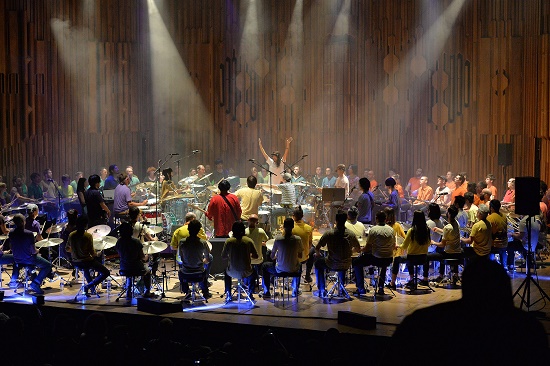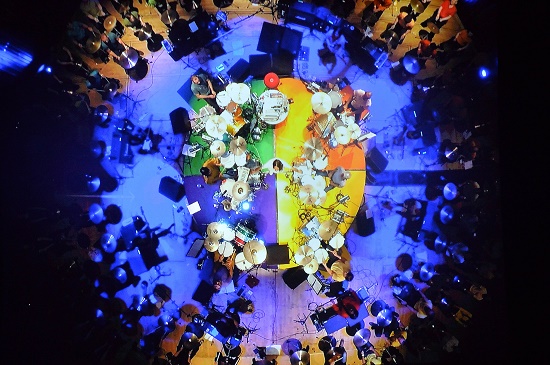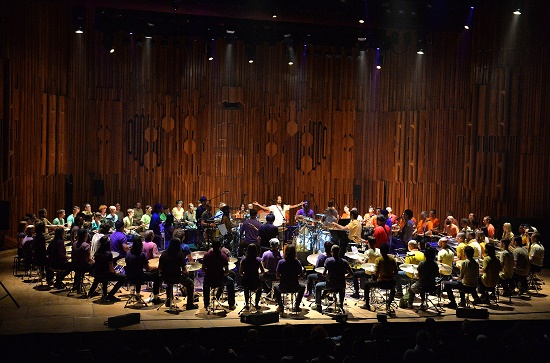On the night we all take our places onstage to cheers from the crowd.
After many hours practice we are prepared to play a two-hour-plus continuous piece maintaining a strong visual element for an audience of 2,000. Reaching inside my pocket for ear-plugs I pull out my case, open it, see its emptiness and my world falls in.
Boredoms have always been about intense multi-layered noise but add in 88 cymbal players and it becomes like standing between two jet engines firing up.
When we start playing, during five painful minutes of cymbal swells climaxing at what feels like the loudest possible volume, my mind ends up in fight or flight mode trying to figure out an alternative to the looming aural lobotomy. There is no escape – I’m stuck here for the duration of the completion of this audio/visual jigsaw.
Suddenly I remember I’d put napkins in my pocket to mop up sweat and spring into action during the first lull. I screwed tissue into my ears once before at a Part Chimp gig and although it was probably as much placebo as real protection it relieved some anxiety in the short term. There is immediate collateral damage as I’m distracted enough to miss my very first cue, eliciting a prompt from my nearest bandmate. This is exactly the kind of spacing-out members of the Boredoms warned us newbies about at rehearsal.
There’s not much comparable to playing a sold out show amongst 88 other cymbal players who include artists you cherish and admire in their number. We are assembled as an avant-noise drum circle, planned meticulously by our hosts as three concentric rings, coded in quarters by four different colours – yellow, orange, green and purple. There are other internal hierarchies within these colours – and that’s even before we get to the music. The composition instructions encompass two A4 sheets for structure and another for Yamakata Eye’s conducting signals. There are sonic themes concerning water; meaning we are to mimic ripple effects, surging tides, crashing waves and splashing sounds, played on the cymbal bell.

Eye is the focal point of the performance but each player adds vital elements. Yoshimi leads most band discussions in Japanese and serves as visual director. (In rehearsal she was also responsible for directions on clothing and advised us on a uniform low cymbal height to maximise audience views into the molten core of madness.) Yojiro Tatekaw is the heartbeat, taking the lead drum patterns with stoic relentlessness and of course joining in the syncopation. Hisham Bharoorcha is the bilingual conduit and orange drum leader, explaining our duties as if it is just another day of making amazing music with locals in whichever city he happens to be in. Each colour has a drum leader and two cymbal leaders in the outer rings as well as two overall cymbal leaders. With so many people it is hard to see but you can usually rely on a cymbal mate next to you, unless they are in the middle of a panic attack. With each run-through, having fully absorbed all references, we start to follow our conductor with increasing intuition.
A collaboration of over 100 musicians demands discipline and timing on and off stage. Logistical challenges include anything from provision of correct equipment to quenching multiple thirsty mouths on a hot weekend. I am assigned purple number 21 after arranging to be in a cymbal section lead by a friend with other mutual friends. Us cymbal types are first convened just a day prior to the show. Like the first day of school, we register, tag our equipment and have photos taken after a quick assembly. In the large practise space the band and cymbal leaders play everything in full. There are collective tingles of excitement as the first note drones out of the forest of instruments. Then we execute a first run through and smooth out some rough edges. Like a well-behaved classroom we are told that we don’t need the back-up rehearsals scheduled for the morning.

Over the course of the two days the artists themselves never express much in way of a reaction either way. This reminds me of a recent study concluding that listening to ‘extreme’ music can induce a calm outlook. There is a thoughtful monkish vibe throughout confirming this zen-theory of noise but ultimately, these guys are pros.
In the gentler moments we play with mallets for that ‘washy’ sound. This is one of the few times the drum leaders address us directly mid-rehearsal. Many, myself included, only have sticks. Yellow drum master Kid Millions of Oneida catches my attention for the change – I shrug my shoulders and he grins knowingly. Being a huge fan I grin back inanely, no doubt going out of time. Luckily this isn’t Whiplash and he doesn’t throw a cymbal at me.
On the morning of the show I spend over an hour wrapping toilet paper, boxer shorts and tubigrip around old sticks. Fellow percussionists fashion much more aesthetically pleasing customisations. DIY culture is represented at the Barbican tonight.
After my mini ear protection meltdown I fancy I play far better than at rehearsal and relax enough to enjoy the spectacle adding flourishes when needed. I also resolve to not ‘cheat’ by only playing the accents and am impressed at our collective stamina. It helps feeling like you are part of a huge tidal wave of energy. My favourite bit is ‘Vision Creation Newsun’ with its manic lead guitar and title repeatedly chanted like a futuristic space mantra.

Soon after there’s the tribal doom section that a friend/fellow player describes as being "a bit Melvins". By this point I am excitedly seat-jiving. At end I feel close to collapse but the hugging made it better. Kid Millions proving himself to be a great human bounds up to me in search of someone and shakes my limp hand. I haven’t done half what he has but we both agree it was an excellent night’s work. I exchange meaningful looks with Boredoms and most other people involved, bask in the admiration from audience friends before helping to drink the free bar dry.
Huge credit to everyone involved. It was an added bonus to receive a thank you email from the Barbican stating the band’s manager Junko was impressed with our musicianship. Friends playing together for friends – but at the Barbican instead of your mate’s house party. By the end everyone present is a lot closer – like an ancient drum cult spewed up by a restless ocean.

